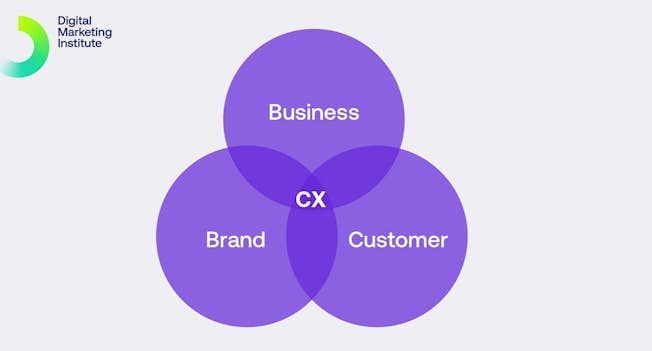
What is Customer Experience (CX)
And why does it matter?

Customer experience (CX) is how consumers perceive the interactions they have with a brand at multiple touchpoints throughout their customer journey.
This can be a query on social media, a conversation with a chatbot or simply navigating on a website from one page to another. Each interaction matters and will have an impact on how future and current customers view a brand.
In fact, 52% of customers will switch to a competitor if they have a single negative impression, according to Zendesk. This makes it crucial for a business to prioritise customer experience which hopefully leads to great customer reviews .
In this article, we explore what CX is and provide simple but effective ways you can differentiate your business from your competitors by covering:
- What is customer experience?
- What is a customer experience pyramid?
- What is customer experience management?
- What impact does CX have on performance?
- What does a CX Manager do?
DMI Guide to Lead Generation and Nurturing
Download Free
What is customer experience (CX)?
In a nutshell, CX involves putting the customer first. It requires a keen focus on the experience a customer has with a brand.
It encompasses everything the customer touches, hears, handles, or sees as they interact with a product or service. CX requires companies to care about their customers and serve them in the best possible way.
It’s worth noting that to deliver a great experience for customers, you need to understand what they want! Creating defined buyer personas can help you get to grips with who your customers are, what they like, and what their pain points are.
The image below shows how business, brand and business all overlap with CX at the core.
What is a CX pyramid?
Once an organisation understands its customer needs, the next step is to set about meeting those needs.
You can use a CX Pyramid to help you do this which is formed by three steps:
- Utility: At the bottom of the pyramid, the Utility step requires an organisation to satisfy the basic requirements of good customer service – delivering a service that is on time, delivered in full, consistent, and offers value.
- Usability: In the middle of the pyramid is the Usability step. Here, the organisation goes one step further, and aims to reduce friction and make its services easier to interact with.
- Pleasurable: Only when the intensive work of the first two steps is complete can the organisation move to the third step – creating pleasure, and measuring how pleasurable customer interactions are at an emotional level.
All too frequently, organisations focus on the pleasurable step at the top of the pyramid, at the expense of the utility experiences at the bottom, which is a mistake. The basic foundations of good customer service should be in place before you attempt to build upon them.
What is customer experience management?
Customer experience is something every organisation manages, whether intentionally or not.
There are no hard and fast rules about what you must do. It’s about understanding that a number of processes, tools, and responsibilities must connect to deliver an overall excellent experience.
Organisations that create exceptional customer experiences know that managing experience is an ongoing process and more a mindset for the entire organisation than just the responsibility of a couple of employees.
CX management involves:
- Managing customer expectations
- Adopting a continual CX mind-set
- Increasing awareness of your brand or product
- Defending yourself against decreasing margins or a race to the bottom
- Increasing customer retention and loyalty
Competing elements
There are a number of competing elements to consider when you’re looking at the overall customer experience:
- What are your organisation’s business priorities (e.g. increased revenue or conversions)?
- How does the business stand out from the crowd, what it is famous for, and how it does things differently?
- How do you satisfy customer needs, how do you meet their goals with minimum friction, and how can you meet their emotional needs?
It can sound like a simple tick-box exercise to satisfy each of these three elements, but you’ll quickly discover there can be conflict and tension between them.
For example, what your customer demands may not necessarily align with your commercial ambitions – and at times, even these can be polarised.
The job of customer experience management is to find the sweet-spot for all three.
What does a CX manager do?
Some businesses may wonder who should be responsible for this role and what are the associated tasks?
With digital channels being a crucial part of the customer journey, digital marketers are often best placed to take on the role of CX Manager and lead awareness of customer experience across a company.
Although delivering an excellent customer experience is everyone’s job, some individuals may not know what exactly they have to do or will have questions on why they should spend their time doing it.
It’s important for a CX Manager to:
- Assess how the brand executes customer experience and the tools or technologies it uses before embarking on a CX transformation.
- Conduct a digital maturity assessment to set realistic goals based on their capability to satisfy customer needs.
- Act as the voice of the customer and bring that voice across the company to have an impact on decision-making at all levels.
What impact does CX have on performance?
Customer experience can at times feel like it’s hard to measure, as it’s made up of so many moving parts – from sales through to service.
Forrester’s annual Customer Experience Index report found that in 2024, CX quality among brands in the US sits at an all-time low after declining for an unprecedented third year in a row.
The decline is due to brands’ inability to provide seamless customer and employee experiences; underwhelming digital experiences using chatbots, and consumers’ concerns about their personal financial situations.
One of the most convincing arguments for why an organisation should pay attention and invest in customer experience is the link between CX and financial performance.
Brands that excel in CX have been seen to increase revenue and return more shareholder value than brands that don’t. So it’s important to measure CX in your organisation, benchmark yourself against competitors, and look to improve areas where you are not performing well.
Use digital channels to attract and engage your audience
There’s no better or faster way to break into the digital industry than with a digital marketing certification. DMI’s certified and industry aligned Professional Diploma in Digital Marketing will teach you the fundamentals of digital marketing, show you how to leverage AI in your marketing activities and simple ways to cultivate soft skills. You’ll also explore key channels such as email marketing, social media, SEO, content marketing, and display and video advertising to execute successful marketing campaigns in any industry.







